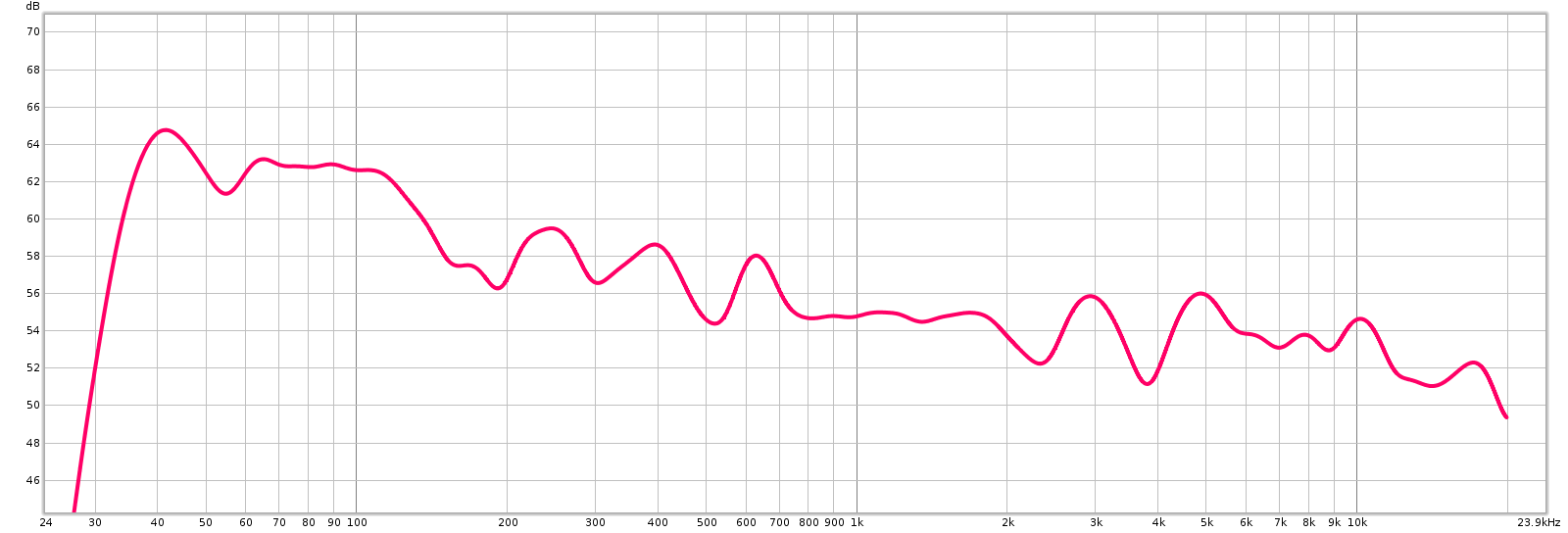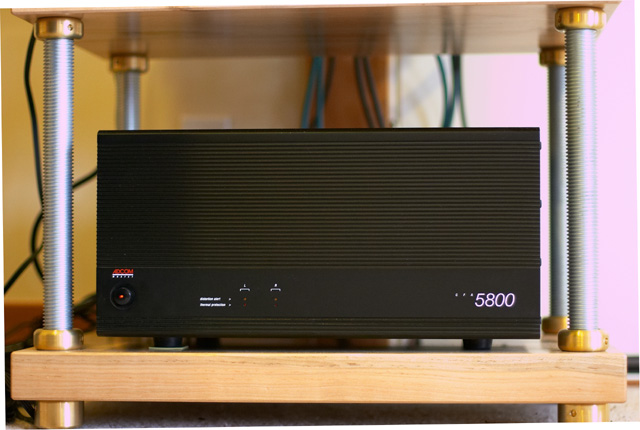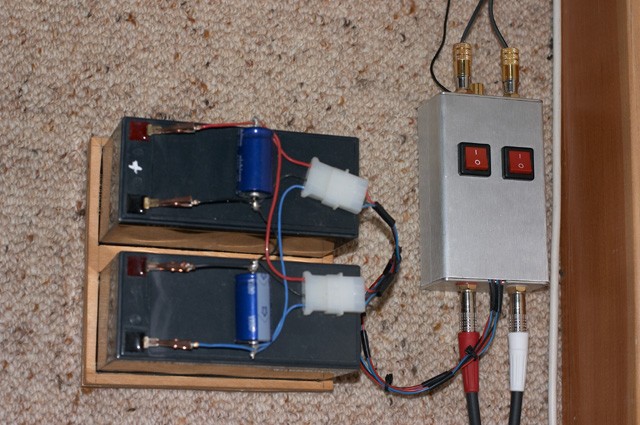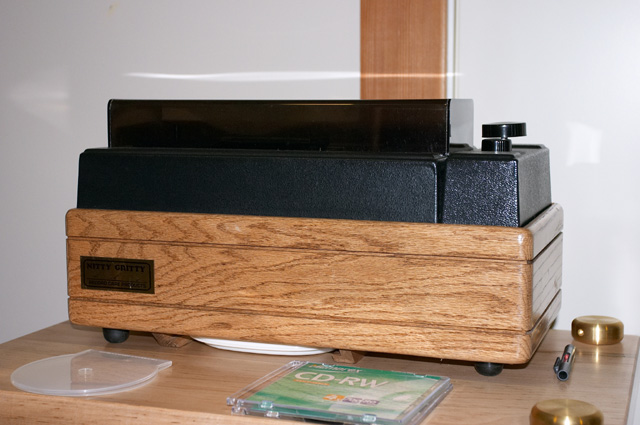My primary audio room system consists of:
Prepared/tuned listening room
Magneplanar 3.6/R speakers
Adcom 5800 amplifier
Oppo HA-1 headphone amp, preamp
Oppo BDP-83 disc player
Thorens TD-318 Mk II turntable
Ortofon MC-30 Mk II low output MC cartridge
DACT CT-100 phono head amp
I'll provide a brief description of each, followed by general observations.
It's often debated whether the room and speakers are the most important part of any audio system.
I believe they are so I'll cover them first.
First and most importantly - the room.
I used a studio mic (Rode NT1A) at my listening couch
to measure 1/3 octave warble tones,
loaded into Audacity,
corrected for mic response,
to find the frequency response at the listening position.
I then rearranged the speakers and room, used
RPG Acoustic Foam
(4 layers thick along the wall behind the listener)
and built my own
tube traps
(21" diameter by 7' tall in the rear room corners),
re-measuring each change,
to get the response as flat and smooth as possible.
I ended up with this:

The blue curve is their frequency response
measured at the listening position in my room.
The curve looks wobbly only because the graph is 2 dB per line.
This is amazingly flat for actual in-room far field response at the listener position -
better than some recording studios!
This is their actual response in my listening room -
not some theoretical specification from a manufacturer's marketing department.
They are flat within 4 dB from 30 Hz to 20 kHz.
More measurements here.
I also installed resistors to attenuate the tweeters for overly bright recordings.
They are optional (bypassed with a switch behind the speaker).
The resistor that came with these speakers for that purpose
had too high an R value (1.2 Ohms) and was a Radio Shack variety resistor that veiled the sound.
I use Mills wire wound, noninductive high power resistors, 1 Ohm each.
It provides 2 dB of attenuation through the upper midrange & treble,
which is subtle but audible, yet retains some "air" in the highs.
Normally I bypass these resistors, but use them for overly bright recordings.
My power amp is an Adcom 5800.

It has plenty of juice to drive my big inefficient Magnepan speakers.
It operates in high bias class AB for low noise and distortion with plenty of power.
It's biased pretty high, drawing about 250 Watts sitting idle.
It can draw almost 2 Kilowatts from the wall while delivering over 400 clean watts of continuous power
to each of my speakers, with 2 dB of headroom which amounts to over 1000 watts of total peak power output.
Its noise floor is below -100 dB with low distortion
and frequency response within 0.25 dB throughout the audible bandwidth.
The 5800's sound is neither "warm", nor "bright", but simply neutral.
The only problem I've had with this amp over the years is the power switch.
Every 5 years or so it fails, leaving the amp permanently ON.
The switch is an inexpensive part (about $20) and easy to replace.
I've owned this amp for about 20 years.
My preamp is an
Oppo HA-1.
It is a DAC, headphone amp and preamp.
Its analog stage is single ended class A balanced
both to headphones, and the line stage to the power amp.
Here's my
review
of the Oppo.
NOTE: I recently said "good-bye" to the
10 kOhm ladder stepped passive attenuator
that I used to use as a preamp.
Next, the
Oppo BDP-83 disk player.
It plays any kind of disc with vanishingly low distortion.
I run the optical digital audio output to the HA-1.
My turntable is a Thorens TD-318 Mk II.
It sits on the floating lid of a 100 lb. sandbox that I built.
The sandbox provides vibration isolation
and the floating lid enables me to get the turntable perfectly level.
This is on top of wool berber carpet with a felt undermat on a solid concrete foundation.
It works - I can stomp on the floor right next to it while recording a blank LP track
on my CD burner and the VU lights don't even blip at -50 dB.
My phono pickup is an
Ortofon MC 30 Super II
low output moving coil.
I measured its frequency response and distortion using the Cardas Test LP,
recording the output on my CD Burner and analyzing it on my computer.
I used this to fine tune the cartridge alignment and loading.
Ortofon recommends 100 Ohms and 100-200 pF.
The ideal loading ended up being 30 Ohms and 100 pF.
This lower resistance tames the rising top end by about 1 dB.
Its response is excellent for an LP system:
-3 dB at 20 Hz, linearly rising to + 1.8 dB at 12 kHz and falling to -2 at 20 kHz.
It's within 2 dB of flat from 40 Hz to 20 kHz with an almost perfectly linear response curve.
With Ortofon's factory recommended loading, it is about +3 dB at 12 kHz.
Some people prefer this brighter sound and perceive it as an enhanced sense of detail or "air".
To my ears it sounds hyper-detailed and artificial.
I prefer the more realistic response.
My phono amp is a
DACT CT-100.

I assembled it from a kit, and designed & built the power supply, box, connectors, etc.
This is the cleanest, most linear phono amp I have ever seen.
At least on paper, it is superior in every measurable way: bandwidth, noise, frequency linearity etc.
to even the most highly regarded (and expensive) phono amps.
It is also the most flexible I have seen.
It is dip switch selectable for gain (from 40 to 80 dB) and cartridge load (10 Ohm - 47k Ohms, 100 - 400 pF),
enabling it to drive virtually every phono cartridge on planet Earth,
and the ability for you to easily adjust loading to tune and optimize your cartridge frequency response.
It has a stiff output stage with an output impedance of 0.1 Ohm,
which makes it ideal for driving my 10k passive attenuator.
What does it sound like? Nothing!
The best LPs are great - rich deep bass, smooth midrange, extremely fast treble, high resolution,
natural tonal balance that is not excessively warm or bright, effortless dynamics.
Even with the 68 dB of gain I use with my low output cartridge, there is no audible background floor of hum or noise.
On a super clean LP the music comes out of a spooky quiet dead silence.
Bad LPs sound... well... bad.
It is not a forgiving phono amp - it gives you the truth - you hear what the LP really sounds like, for better or for worse.

Vinyl doesn't sound good unless it's clean, and that is the job of my Nitty Gritty 2.5 FI record cleaner.
I brew my own cleaning solution distilled water and isopropyl alcohol; here's the
recipe.
It has a replaceable "vac-sweep" pad with small holes through which cleaning fluid is injected
while it slowly spins the record.
After a few turns you flick the switch and a powerful vacuum draws from the center of the vac-sweep pad
while the record continues to spin.
It does the job as well as it can be done - nothing I know of gets records cleaner.
After a few years it did have a problem - the fluid started leaking!
I took it apart to find it was leaking where the hoses inside connect to the fluid tank.
I took it apart and glued them back several times,
trying 5 minute expoxy, 60 minute epoxy, marine epoxy and adhesive caulk.
None of them worked - each time, eventually the alcohol solution would eat them up and leak out.
I was almost ready to buy a new one until I saw the price: about $1 kilobuck.
That is more than twice what I paid for mine about 12 years ago!
For that price I was determined to fix it myself.
Finally, I found something that worked:
PC-11 epoxy.
This stuff does the job and the cleaning solution never eats it away or leaks out.

My Tuner is a
Sangean HDT-1X.
It is an HD Radio tuner with a unique design.
You can read more about it
here.
It has excellent sensitivity, tunes HD Radio stations, and has good sound quality.
It has a digital optical output which connects directly to my CD burner,
so I can bypass unnecessary D->A and A-> stages when recording.
My speaker cables are regular old 12 gauge fine stranded copper with locking banana plugs soldered on.
Most of my RCA interconnect cables are Tara Labs Prism 22.
They don't necessarily sound any different,
but have nicer shielding and more solid connectors than regular old cheap cables.
The passive attenuator can have high output impedance,
so low capacitance cable to connect to the amp is essential,
else high frequencies might be attenuated.
Here I use
Blue Jeans Cable LC-1.
At 12.2 pF / foot its capacitance is about as low as it gets.




